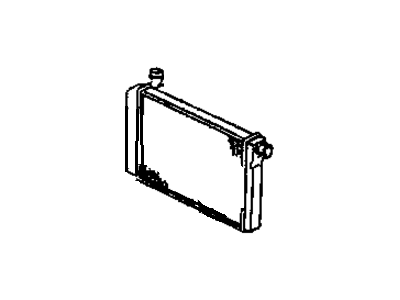
My Garage
My Account
Cart
Genuine Pontiac Phoenix Radiator
Cooling Radiator- Select Vehicle by Model
- Select Vehicle by VIN
Select Vehicle by Model
orMake
Model
Year
Select Vehicle by VIN
For the most accurate results, select vehicle by your VIN (Vehicle Identification Number).
1 Radiator found
Pontiac Phoenix Radiator
The Pontiac Phoenix Radiator work as an essential part of the car's cooling system where it takes heat from the engine coolant, then dispersed it through a heat exchange mechanism. Generically, Pontiac Phoenix Radiators have a combination of fins and tubes and inlet and outlet tanks normally; these radiators' core and tanks are dominantly made of aluminium but copper /brass type of cores and tanks are also present. The radiator is placed at the front part of vehicle exposing it to greater airflow for effectively removing heat. They are performance radiators designed from lightweight aluminum with sophisticated features; possess more spacious tubes and higher fin density to provide efficient heat exchanges and cool the engine properly than the factory units. Regardless of being direct-fit or universal models, Pontiac Phoenix Radiators have better cooling capabilities; and the OE size inlets and outlets ensure that its installation is easy.
Each OEM Pontiac Phoenix Radiator we offer is competitively priced and comes with the assurance of the manufacturer's warranty for the part. Furthermore, we guarantee the speedy delivery of your orders right to your doorstep. Our hassle-free return policy is also in place for your peace of mind.
Pontiac Phoenix Radiator Parts Questions & Experts Answers
- Q: How to remove and install a radiator on Pontiac Phoenix?A:Disconnect the negative battery cable. Open the drain valve on the lower right side of the radiator and drain the coolant into a suitable container. Remove the pivoting engine mount brace that attaches to the radiator support. Remove the fan. Mark the position of the hood latch on the radiator support with a sharp scribe or pencil and remove the hood latch. Remove the coolant recovery tank hose from the radiator neck. Disconnect the upper and lower coolant hoses from the radiator. Disconnect the transmission oil cooler lines from the radiator. Immediately plug the lines so fluid does not leak from them. Remove the radiator mounting bolts and clamps. Lift the radiator out of the engine compartment. Note: If the car is equipped with air conditioning it may be necessary to raise the lefthand side of the radiator first to clear the radiator neck from the A/C compressor. If coolant drips on any body paint, immediately wash it off with water as the anti-freeze solution can damage the finish. With the radiator removed, it can be inspected for leaks or damage. If in need of repairs, have a professional radiator shop or dealer perform the work as special welding techniques are required. Bugs and dirt can be cleaned from the radiator by using compressed air and a soft brush. Do not bend the cooling fins as this is done. To install the radiator, place it in position so the bottom of the radiator is in the lower mounting pads and install the mounting clamp and bolts. Torque the bolts to specs. The remainder of the installation procedure is the reverse of the removal procedure. After installation, fill the cooling system. Start the engine and check for leaks. Allow the engine to reach normal operating temperature (upper radiator hose hot) and add coolant until the level reaches the bottom of the filler neck.









